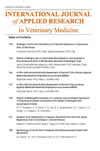Genetic and geographical integration for ruminant production under climate change with particular emphasis on Brazil
4区 农林科学
Q4 Veterinary
International Journal of Applied Research in Veterinary Medicine
Pub Date : 2022-01-01
DOI:10.31893/avr.2022009
引用次数: 3
Abstract
The use of georeferencing technologies and genetic information has increased to integrate management and planning of livestock production systems, predict adaptive capacities, and aid in developing strategies for national Animal Genetic Resource Conservation Programs. Researchers and farmers can use this information to define conservation objectives for individual breeds and examine environmental factors that affect extinction risk, such as disease threats. Molecular markers and geographic information come together in landscape genetics, a combination of landscape ecology and population genetics, to provide information on the interaction between landscape and evolutionary processes. Results reveal attributes that affect genetic adaptation to specific environmental stressors such as diseases, parasites, extreme heat, vegetation type, lack of water, or combinations. Recent preliminary studies in Brazil used these tools to identify the regional usage patterns for animal production based on environmental criteria and breed distribution data. The results have been used as a further criterion to optimise in situ, and ex situ conservation schemes and plan expansion and adaptation of production systems. The use of production environment descriptors and climatic and genetic information will help maintain animal production systems in a changing world气候变化下反刍动物生产的遗传和地理整合,特别强调巴西
地理参考技术和遗传信息的使用已经增加,以整合畜牧生产系统的管理和规划,预测适应能力,并帮助制定国家动物遗传资源保护计划的战略。研究人员和农民可以利用这些信息来确定单个品种的保护目标,并检查影响灭绝风险的环境因素,例如疾病威胁。景观遗传学是景观生态学和种群遗传学的结合,它将分子标记和地理信息结合在一起,提供景观与进化过程相互作用的信息。结果揭示了影响遗传适应特定环境压力的属性,如疾病、寄生虫、极端高温、植被类型、缺水或组合。最近在巴西进行的初步研究利用这些工具,根据环境标准和品种分布数据确定了动物生产的区域使用模式。研究结果已被用作进一步优化原地和非原地保护方案以及计划扩大和适应生产系统的标准。使用生产环境描述符以及气候和遗传信息将有助于在不断变化的世界中维持动物生产系统
本文章由计算机程序翻译,如有差异,请以英文原文为准。
求助全文
约1分钟内获得全文
求助全文
来源期刊
自引率
0.00%
发文量
1
审稿时长
3 months
期刊介绍:
The International Journal of Applied Research in Veterinary Medicine promotes excellence in the clinical practice of veterinary medicine by disseminating fundamental scientific, diagnostic, and treatment knowledge gained from prospective and retrospective research in a timely manner. The Journal fulfills its mission through rapid peer review of each submitted article, and publication of all articles within 90 days of acceptance. All published articles meet the standards of Balance, Independence, Objectivity and Scientific Rigor.

 求助内容:
求助内容: 应助结果提醒方式:
应助结果提醒方式:


